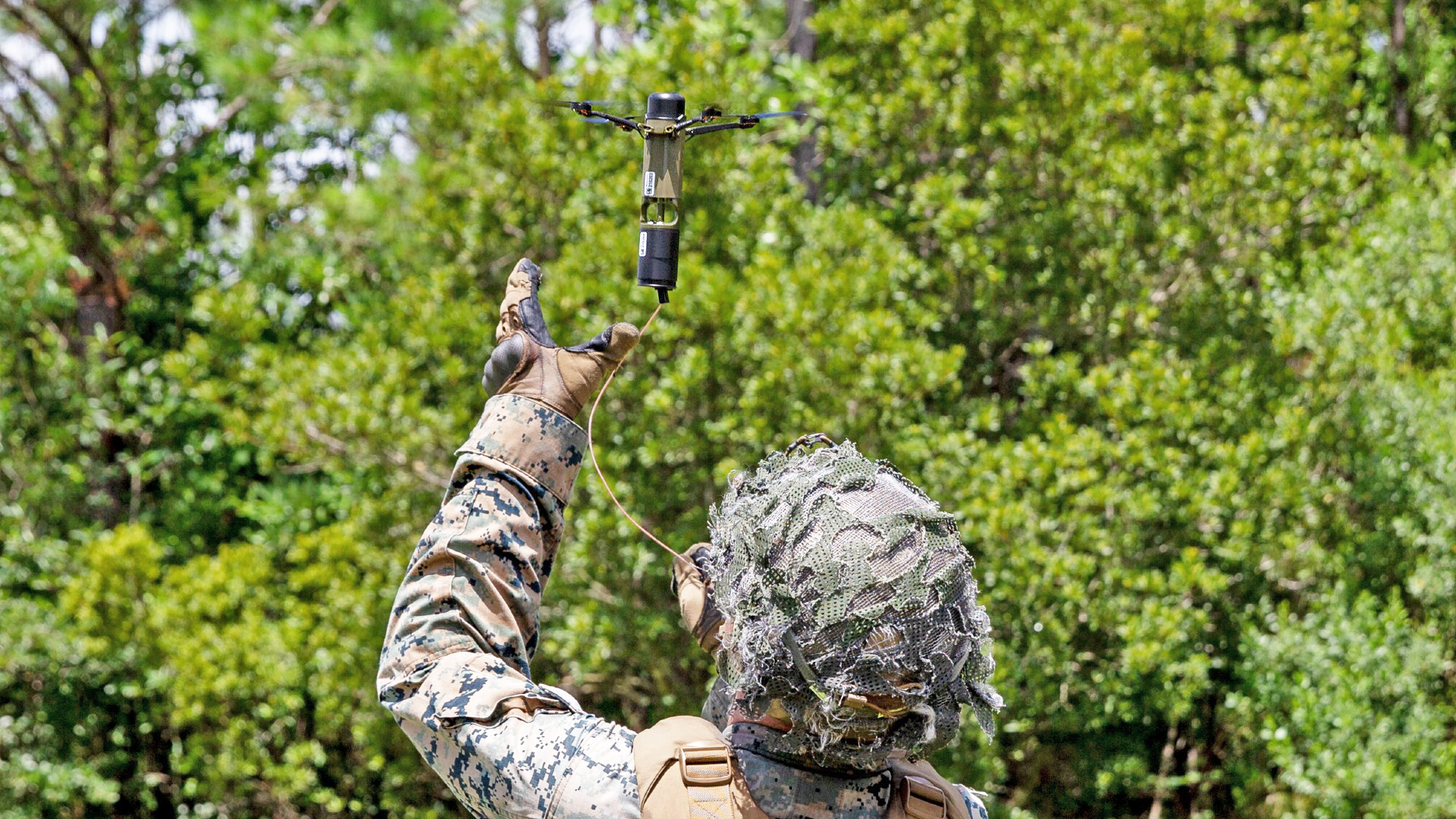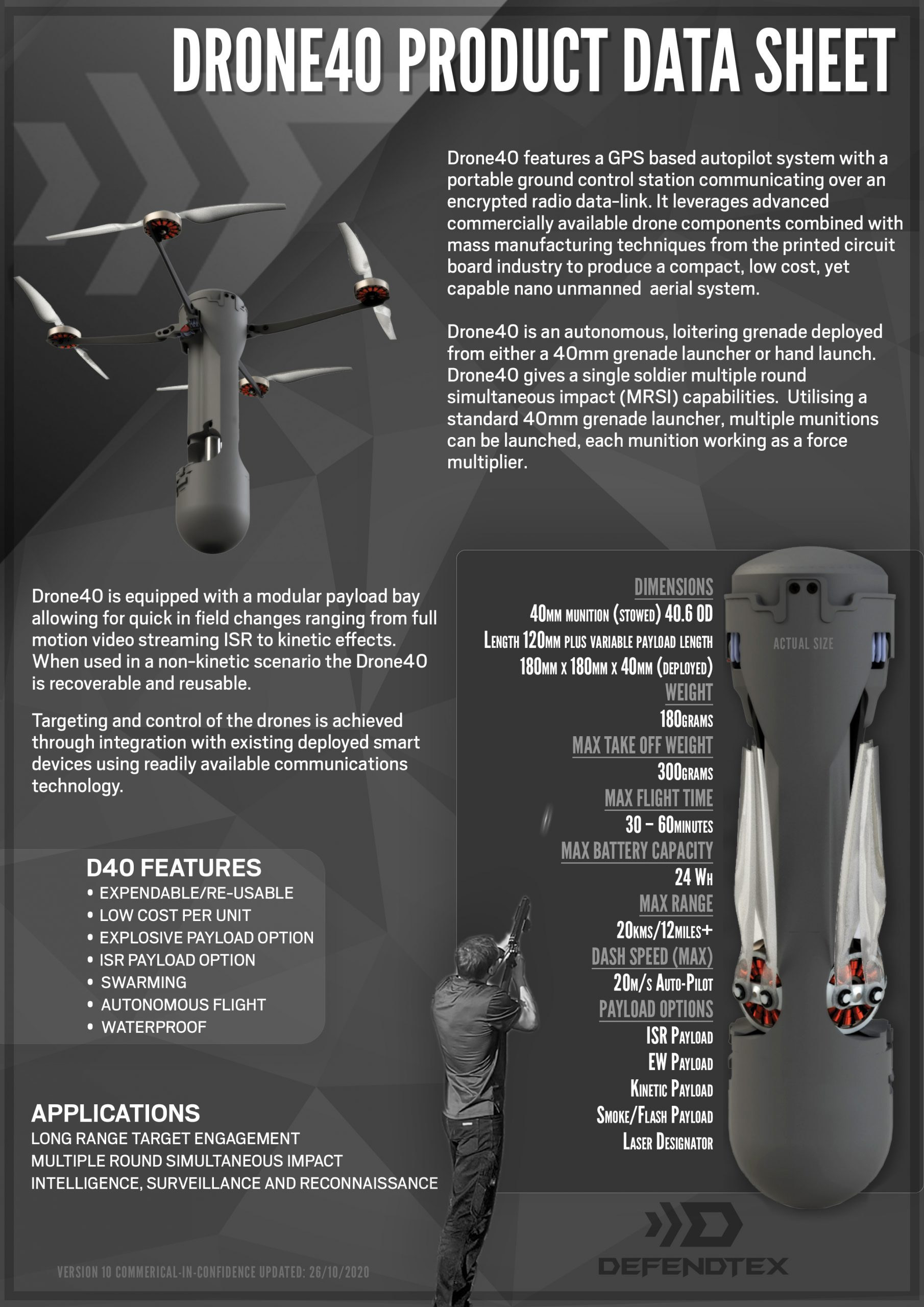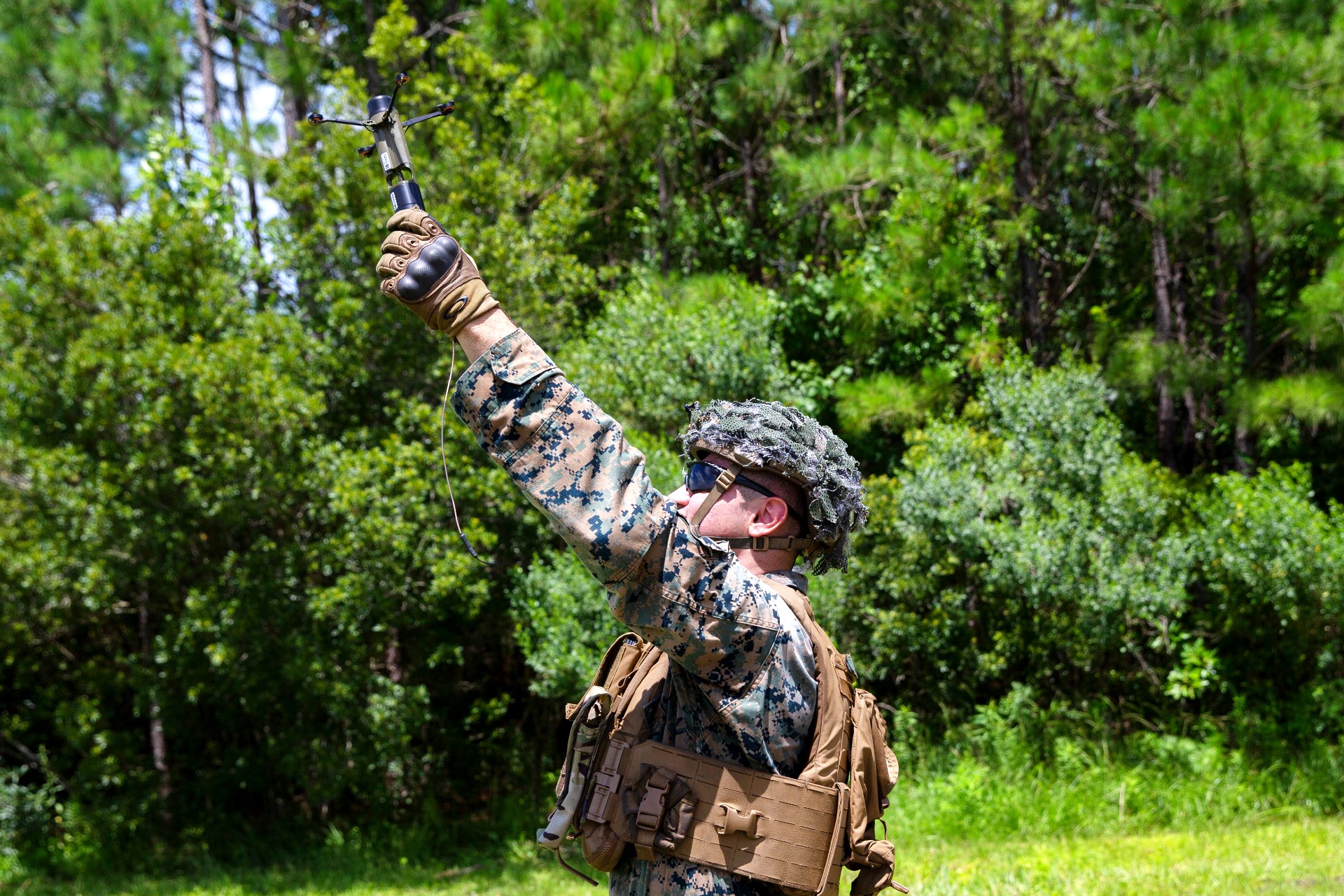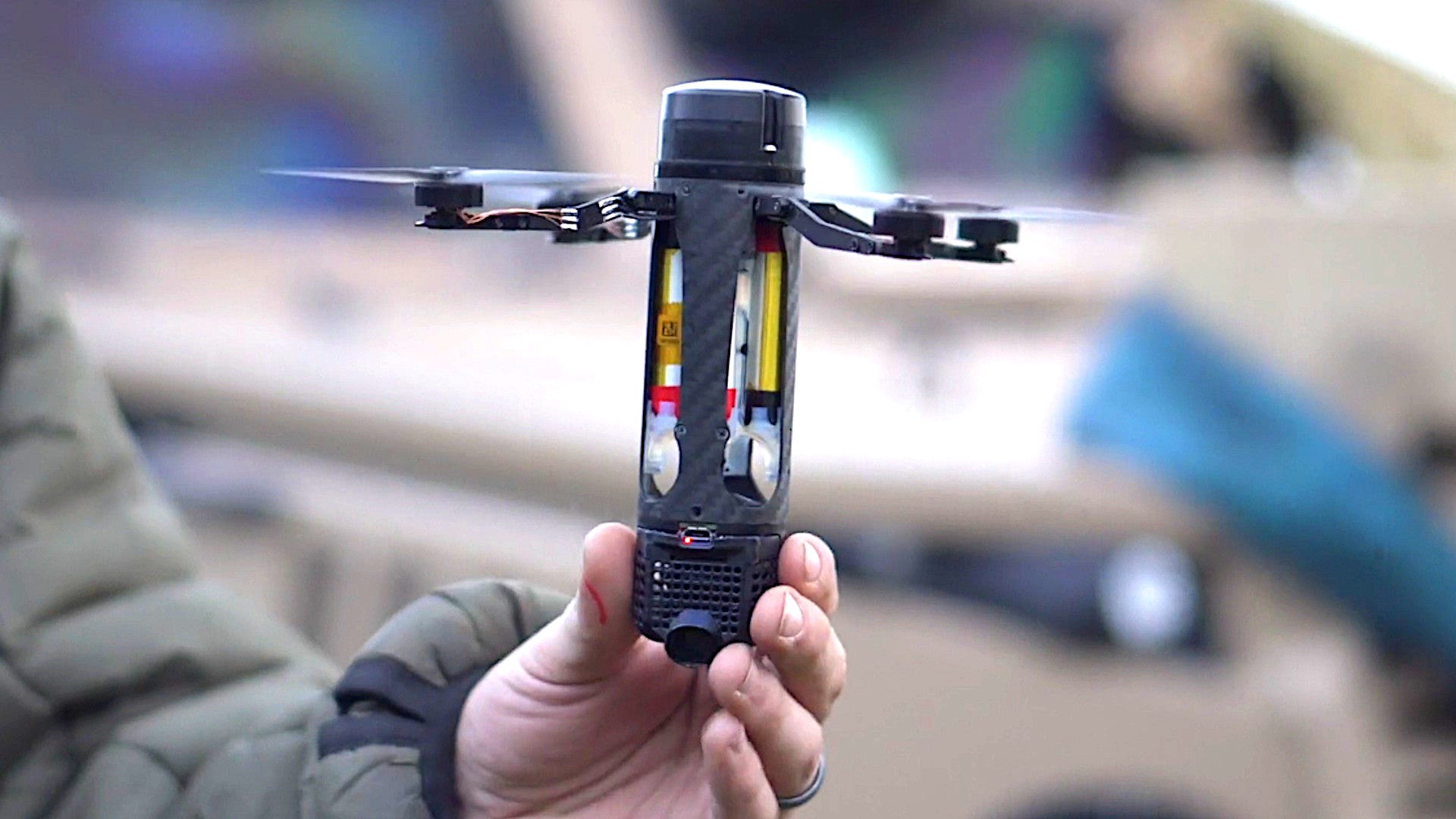Images shared online by the United States Marine Corps this week show Marines conducting training exercises with the Drone40, a miniaturized, low-cost, expendable drone that can be deployed by hand or launched from a 40mm grenade launcher. While other nations have deployed the Drone40 in overseas operations, this is the first time U.S. troops have been seen training with the versatile, potentially game-changing unmanned systems, which can carry a wide variety of payloads, including various sensors or small high-explosive warheads.
The Drone40 tests were conducted by the 1st Battalion, 2nd Marine Regiment, part of the 2nd Marine Division, and took place at Camp Lejeune in North Carolina on July 7, 2021. According to the captions accompanying the pictures shared by the USMC, this unit is an “experimental infantry battalion to test new gear, operating concepts and force structures.”

The Drone40 was previously deployed earlier this year by British Army forces carrying out peacekeeping missions in the northwest African country of Mali. As we noted at the time, the Drone40 could fit inside launchers designed to fire 40mm rounds, such as variants of the Heckler & Koch AG36 under-barrel grenade launcher, used by both U.K. and U.S. forces, among others. So far, the British forces that brought the drones to Mali have used only hand-launched versions configured for surveillance and reconnaissance missions.
The Drone40 is manufactured by Australian defense contractor DefendTex, who claim the tiny unmanned quadcopter can be equipped with a wide variety of payloads including full-motion electro-optical video cameras, electronic warfare systems, and laser designators, as well as smoke or flash-producing systems. The Drone40 can even be configured to carry small high-explosive or armor-piercing warheads.
The drones measure just seven inches in length and weigh under half a pound. Multiple Drone40s can operate together as a swarm after launch, or even network together with other UAS platforms to operate as a heterogenous swarm. Aside from being deployed by hand or from grenade launchers, a video on DefendTex’s website shows the drones operating in a launch-on-demand swarming mode after taking off from tubes placed on the ground.
The drones are reusable when employed in a way that doesn’t result in their destruction, and DefendTex even says they are waterproof, which could make them suitable for recovery when used in missions at sea or in bad weather. A fact sheet from the DefendTex website states that the drones’ targeting and control functions can be accomplished via “integration with existing deployed smart devices using readily available communications technology” and an encrypted radio datalink to a portable ground control station. In addition, the Drone40 boasts a GPS-based autopilot system.

The claimed wide-ranging payload options mean the Drone40 can fit into many different roles. Units could launch the drones from behind cover to surveil enemy positions or even carry out attacks from above directly when fitted with the small warheads. The laser designator versions could paint targets that could be engaged by precision-guided munitions. The smoke payload could be used to shield friendly forces’ movements, while the one designed to produce a bright flash could turn the drone into a very flexible less-than-lethal weapon.
The drones’ manufacturer even claims that the Drone40’s swarming capabilities could enable what is called “multiple round simultaneous impact,” or MSRI. This means a single soldier could launch two or more drones with explosive warheads that would then loiter in the air until being order to swoop down on multiple targets a the same time. If multiple-warhead types were deployed in a single salvo, a relatively small force of Drone40-equipped units could engage complex and dispersed targets simultaneously, such as armored vehicles and the troops standing in the open beside them.

While we’ve only seen the Marines employing these in a handheld mode so far, they could certainly take advantage of the grenade launched mode, as well. The USMC announced in 2019 that it would transition from the M203 grenade launcher to the M320, which offers greater range and accuracy. In addition, unlike the Army, the Marines also field the six-round M32A1. While it’s not clear whether or not the Drone40 is compatible with the M32A1, it would certainly be an impressive combination if it was.
The captions that accompanied the new images of Marines testing the Drone40 state that the 2nd Marine Division’s mission is to “refine infantry battalions across the Marine Corps in accordance with Force Design 2030.” In a 2021 annual report, General David Berger, Commandant of the Marine Corps, wrote that Force Design 2030 is a modernization effort that helps the Marines prepare to “better fulfill our role as the nation’s naval expeditionary force-in-readiness.”
Last year’s Force Design 2030 report states that “the Marine Corps requires a family of UAS capabilities” and must “transition from our current UAS platforms to capabilities that can operate from ship, from shore, and able to employ both collection and lethal payloads.” The Drone40 seems like it could fit into this goal, as it boasts a flight time of 30 to 60 minutes, a range of 12 miles, and can carry both types of payloads specified in the 2020 Force Design 2030 white paper.

The Marine Corps has tested a wide variety of UAVs in recent years including man-portable suicide drones and the MartinUAV V-Bat. The Drone40 is somewhat different, though, in that its tiny size makes it far more portable and versatile than these other, larger models. Diminutive, hand-launched drones similar to the Drone40 are currently operated by the U.S. Army, such as the tiny Black Hornet. You can read more about the Black Hornet, which is now being deployed by almost 20 different countries, in this past War Zone piece.
The Marines have also been eager to push small UASs all the way down to the squad level for years now, and the Drone40 could be perfectly suited to fit that role. Small tactical drones “organic to tactical maneuver units, generally at the battalion level and below provide battlespace awareness and target development in support of squads, platoons, companies, battalions and Marine Special Operations Teams and Companies,” Marine Corps Combat Development Command/Combat Development & Integration said in 2019.
The Drone40 is yet another example of how small drones and other unmanned assets are becoming integrated into battlefield operations around the world at even the lowest operational levels. Tactical, versatile drones launched by individual soldiers could be transformational in terms of how America’s expeditionary forces conduct warfare, allowing small units to carry out attacks that would previously require a wide variety of assets including air support.
Contact the author: Brett@TheDrive.com
